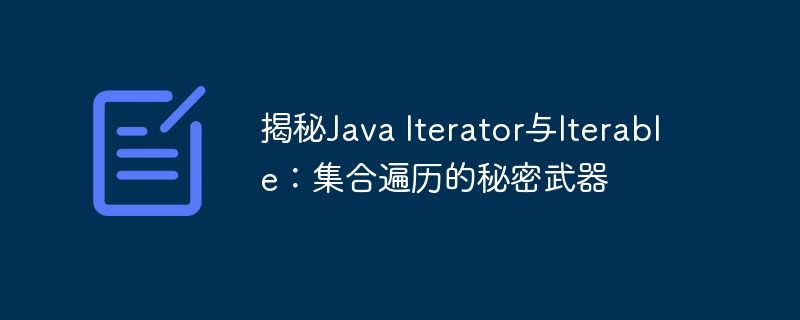Home >Java >javaTutorial >Revealing the secrets of Java Iterator and Iterable: the secret weapon of collection traversal
Revealing the secrets of Java Iterator and Iterable: the secret weapon of collection traversal
- 王林forward
- 2024-02-19 23:39:08930browse

php editor Xinyi reveals the collection traversal skills of Iterator and Iterable in Java. Iterator is an interface used to traverse the elements of a collection, while Iterable is a class that implements the Iterable interface and can be traversed through an iterator. Understanding the relationship and usage between them allows you to operate collection data more flexibly and efficiently and improve programming efficiency. In Java programming, Iterator and Iterable are the secret weapons of collection traversal. Mastering their usage skills will be of great benefit to your programming work.
Iterator: A powerful tool for traversing collection elements
Iterator is one of the core interfaces of the Java collection framework, which provides methods for traversing collection elements. Through Iterator, we can access the elements in the collection one by one. Iterator has the following main methods:
- hasNext(): Check whether the next element exists.
- next(): Returns the next element.
- remove(): Delete the current element.
Iterable: The cornerstone of iterable objects
Iterable is another important interface of the Java collection framework, which defines the iterability of the collection. Classes that implement the Iterable interface are called iterable objects, that is, objects that can be traversed. The Iterable interface has only one method:
- iterator(): Returns an Iterator instance for traversing the iterable object.
The powerful combination of Iterator and Iterable
Iterator and Iterable provide a powerful combination that can easily implement collection traversal operations. For a collection that implements the Iterable interface, we can obtain an Iterator instance through the iterator() method of the collection object, and then use the Iterator method to traverse the collection elements. Usually, we do not need to use Iterable directly, but traverse the collection elements through an enhanced for loop or the Collections.forEach() method. The syntax of the enhanced for loop is:
for (元素类型 元素变量 : 集合对象) {
// 遍历集合元素
}
Sample code: Traversing ArrayList
import java.util.ArrayList;
import java.util.Iterator;
public class Main {
public static void main(String[] args) {
ArrayList<String> names = new ArrayList<>();
names.add("Alice");
names.add("Bob");
names.add("Carol");
// 使用迭代器遍历集合
Iterator<String> iterator = names.iterator();
while (iterator.hasNext()) {
String name = iterator.next();
System.out.println(name);
}
// 使用增强型for循环遍历集合
for (String name : names) {
System.out.println(name);
}
}
}
Run this code and the output will be:
Alice Bob Carol
Summarize
Iterator and Iterable are powerful tools in the Java collection framework, which can easily implement collection traversal operations. Iterator provides a method to traverse the elements of a collection, while Iterable defines the iterability of a collection. Through the cooperation of Iterator and Iterable, we can easily traverse the elements in the collection to perform various data processing operations.
The above is the detailed content of Revealing the secrets of Java Iterator and Iterable: the secret weapon of collection traversal. For more information, please follow other related articles on the PHP Chinese website!
Related articles
See more- PHP iterator and iteration implementation and usage analysis PHP skills
- Directory iterator for php
- The difference between python generators and iterators
- Python detailed analysis of containers, iterable objects, iterators and generators
- Java Collection Traversal Guide: Tips on Using Iterator and Iterable

